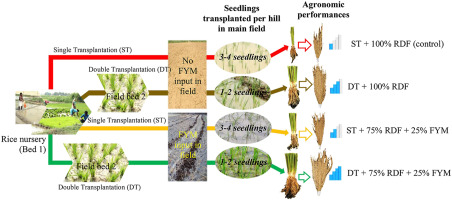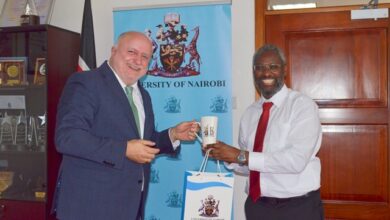Double transplantation as a climate resilient and sustainable resource management strategy for rice production in eastern Uttar Pradesh, north India

Optimizing innovative crop production strategies for various agro-climatic regions of the world is critical for keeping food production within planetary boundaries while meeting the UN-Sustainable Development Goals (UN-SDGs) and achieving global sustainability (Rockström et al., 2009). Sustainable and resilient practices are also essential for ensuring food production in times of climate change and associated global environmental changes (Eisenstein, 2020). It has been estimated that agriculture alone accounts for the largest water usage (∼70%) (Walter et al., 2017) and leads to the largest non-point sources of pollution due to the rampant use of agrochemicals like pesticides and fertilisers (Rhind, 2009). Hence, the validation of promising cultivation practices for saving critical natural resources like water is essential and indeed the need of the hour (Dubey et al., 2022). Also, the adoption of suitable cultivation practices that stimulate the soil microbiota (Elhaissoufi et al., 2021), innate endurance and tolerance of crops against pests and diseases, floods, submergence, and water lodging, etc. is also important for food production under the changing climatic conditions (Khatoon et al., 2020; Harindintwali et al., 2021; Maroli et al., 2021; Thompson et al., 2022).
Rice is one of the important rainfed crops and is a staple diet in most of the Asian countries (where >90% of the world’s rice is produced) and parts of the Pacific (www.fao.org). According to the estimates of the Food and Agriculture Organization of the United Nations (UN-FAO), more than half of the global population relies on rice for calories and protein (www.fao.org). In order to feed a rapidly growing population, especially in developing nations, food production would need to almost double (www.fao.org). However, on one hand, increasing population and resultant land-use changes (especially for urbanisation and other developmental activities) reduce the per-capita land availability for agriculture (Zuo et al., 2018), whereas intensive cultivation practices reduce the quality of soil and thereby the agricultural yield, including rice production (Dubey et al., 2022). On the other hand, erratic weather events such as changing rainfall patterns, droughts, flooding, submergence, occurrence and prevalence of newer pests and diseases, etc., undermine the productivity of rice (Wheeler and Braun, 2013). Therefore, the adoption of climate-resilient and planet-friendly cultivation of rice is essential for ensuring food and nutritional security in India and other Asian countries (Cui et al., 2018; Ishfaq et al., 2020; Panneerselvam et al., 2020; Ji et al., 2021; Banayo et al., 2022).
Innovative rice cultivation practices are being reported from different rice cultivating regions across the world. These practices include providing smallholder farming communities with science-and evidence-based management practices such as dry direct seeded rice cultivation to help them cope with challenges (Alam et al., 2018; Cui et al., 2018; Ishfaq et al., 2020), sustainable intensification (Zuo et al., 2018), investigating the synergistic effects of nutrients (Ji et al., 2021), deploying modern molecular tools for improving desirable traits in rice i.e., improving seed germination, growth, yield, tolerance, and nutritional quality (Zhang et al., 2020; Reddy et al., 2021; Ayaad et al., 2021), engineering soil microbiome by co-inoculation of plant-growth promoting microorganisms (Kumar and Dubey, 2020), adoption of organic and resource conserving practices (Dubey et al., 2022), farm mechanization (https://www.irri.org/mechanization-and-postharvest) and engineering of the soil microbiome. However, the adoption of various technologies by marginal and subsistence farmers in developing nations mainly depends upon their cost-effectiveness as well as their willingness to adopt (i.e., social, or cultural barriers). Therefore, the validation of suitable cultivation strategies that can be easily employed by the local farmers is of paramount significance.
Like in other Asian countries, rice is also a staple crop in India, cultivated on ∼44 Mha of land and contributing 20% of the total rice production across the world (Gujja and Thiyagarajan 2009). It has been predicted that rice production has to be increased to 130 Mt by 2030 to feed a growing Indian population (Gujja and Thiyagarajan 2009). However, 13.6 Mha of land is prone to drought, 2.25 Mha faces flood and 6 Mha of land is prone to submergence and waterlogging conditions, which results in a significant yield gap (Barah, 2005; Gujja and Thiyagarajan 2009; Pandey and Bhandari, 2022). Smallholding and marginalized farmers are more vulnerable to these stresses as they mostly utilize lowlands for rice production due to its relatively low rental/purchasing cost (Mohanty and Yamano, 2017; Kumar et al., 2019). Reducing a yield gap of 1.3–1.8 million tonnes can result in 300–400 USD ha−1 of additional benefits (Mohanty and Yamano, 2017). As a result, documenting, validating, and upscaling climate adaptive and innovative farm practices is critical for increasing the productivity of rainfed crops, particularly rice, under changing conditions (Dubey et al., 2020, 2022). Also, exploiting the native ecological knowledge of farmers is essential to conserve critical natural resources. While rice is commonly cultivated by a single transplantation method, double transplantation is an alternative method adopted by very few small/medium farmers in some S.E. Asian countries like Bangladesh, India, Nepal, and Myanmar (Azad and Hossain, 2006; Khatun et al., 2007; Ashem et al., 2010; Singh et al., 2017; Kumar et al., 2019). Though rice is commonly cultivated in most of the Indian states, only a small number of farmers (mainly tribal communities) in a few states like Assam, Bihar, Meghalaya, West Bengal and eastern Uttar Pradesh are practicing double transplantation (Singh et al. 2003, 2017; Khatun et al., 2007; Satapathy et al., 2015; Das et al., 2017; Kumar et al., 2019). However, no detailed studies are available on the overall sustainability assessment of the double transplantation method in rice i.e., unveiling its social, environment, and economic importance as well as its linkage with UN SDG goals and target. As a result, the current study was aimed to: (i) examine the level of adoption of double transplantation by local farmers in five different districts of eastern Uttar Pradesh (UP), North India; (ii) investigate the ecological and economic benefits of double transplantation used in two experimental fields in two different agro-climatic zones (one in the Indo-Gangetic flood-plain and the other in the dryland of the Vindhyan hill region) of eastern UP, with or without the addition of farmyard manure; and (iii) assess the nexus between double transplantation practice and UN-SDGs in Indian context, and thereby develop a suitable package of practices for sustainable rice production in eastern Uttar Pradesh, North India.



